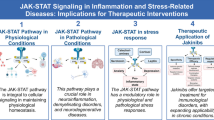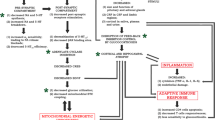Abstract
Stress is considered as a major cause of depression. C-Jun N-terminal kinase (JNK) is a member of the stress-induced mitogen activated protein (MAP) kinase family which is often activated through phosphorylation. Clinical studies and animal experiments have found that abnormal phosphorylation/activation of JNK exists in the occurrence of various psychiatric diseases. Recently, several studies linked JNK kinase activity to depression. However, whether excessive activation of JNK activity is directly responsible for the occurrence of depression and the underlying mechanisms remain unclear. Here, we constructed a conditional transgenic mouse which is specifically expressing MKK7-JNK1 (CAJNK1) in the central nervous system. CAJNK1 mice showed activation of JNK and lead to depression-like behavior in mice. Transcriptome analysis indicates reduced expression of synaptic-associated genes in CAJNK1 mice brains. Consistently, we found abnormal dendritic spine development and PSD95 downregulation in CAJNK1 hippocampal neurons. Our studies provide compelling evidence that activation of JNK as an intrinsic factor leading to depression-like behavior in mice provides direct clues for targeting the JNK activity as a potential therapeutic strategy for depression.






Similar content being viewed by others
Data availability
The datasets during and/or analyzed during the current study are available from the corresponding author on reasonable request.
References
Tafet GE, Nemeroff CB (2016) The links between stress and depression: psychoneuroendocrinological, genetic, and environmental interactions. J Neuropsychiatry Clin Neurosci 28(2):77–88. https://doi.org/10.1176/appi.neuropsych.15030053
Krishnan V, Nestler EJ (2011) Animal models of depression: molecular perspectives. Curr Top Behav Neurosci 7:121–147. https://doi.org/10.1007/7854_2010_108
Park C, Rosenblat JD, Brietzke E, Pan Z, Lee Y, Cao B et al (2019) Stress, epigenetics and depression: a systematic review. Neurosci Biobehav Rev 102:139–152. https://doi.org/10.1016/j.neubiorev.2019.04.010
Deussing JM, Jakovcevski M (2017) Histone modifications in major depressive disorder and related rodent models. Adv Exp Med Biol 978:169–183. https://doi.org/10.1007/978-3-319-53889-1_9
Cargnello M, Roux PP (2011) Activation and function of the MAPKs and their substrates, the MAPK-activated protein kinases. Microbiol Mol Biol Rev 75(1):50–83. https://doi.org/10.1128/MMBR.00031-10
Sabapathy K (2012) Role of the JNK pathway in human diseases. Prog Mol Biol Transl Sci 106:145–169. https://doi.org/10.1016/B978-0-12-396456-4.00013-4
Busquets O, Parcerisas A, Verdaguer E, Ettcheto M, Camins A, Beas-Zarate C et al (2020) c-Jun N-terminal kinases in Alzheimer’s disease: a possible target for the modulation of the earliest alterations. J Alzheimers Dis. https://doi.org/10.3233/jad-201053
Liu W, Ge T, Leng Y, Pan Z, Fan J, Yang W et al (2017) The role of neural plasticity in depression: from hippocampus to prefrontal cortex. Neural Plast 2017:6871089. https://doi.org/10.1155/2017/6871089
Roseman L, Demetriou L, Wall MB, Nutt DJ, Carhart-Harris RL (2018) Increased amygdala responses to emotional faces after psilocybin for treatment-resistant depression. Neuropharmacology 142:263–269. https://doi.org/10.1016/j.neuropharm.2017.12.041
Tunc-Ozcan E, Peng CY, Zhu Y, Dunlop SR, Contractor A, Kessler JA (2019) Activating newborn neurons suppresses depression and anxiety-like behaviors. Nat Commun 10(1):3768. https://doi.org/10.1038/s41467-019-11641-8
Berridge MJ (2017) Vitamin D and depression: cellular and regulatory mechanisms. Pharmacol Rev 69(2):80–92. https://doi.org/10.1124/pr.116.013227
Mohammad H, Marchisella F, Ortega-Martinez S, Hollos P, Eerola K, Komulainen E et al (2018) JNK1 controls adult hippocampal neurogenesis and imposes cell-autonomous control of anxiety behaviour from the neurogenic niche. Mol Psychiatry 23(2):362–374. https://doi.org/10.1038/mp.2016.203
Holmes SE, Scheinost D, Finnema SJ, Naganawa M, Davis MT, DellaGioia N et al (2019) Lower synaptic density is associated with depression severity and network alterations. Nat Commun 10(1):1529. https://doi.org/10.1038/s41467-019-09562-7
Xu D, Zhang F, Wang Y, Sun Y, Xu Z (2014) Microcephaly-associated protein WDR62 regulates neurogenesis through JNK1 in the developing neocortex. Cell Rep 6(1):104–116. https://doi.org/10.1016/j.celrep.2013.12.016
Xu D, Yao M, Wang Y, Yuan L, Hoeck JD, Yu J et al (2018) MEKK3 coordinates with FBW7 to regulate WDR62 stability and neurogenesis. PLoS Biol 16(12):e2006613. https://doi.org/10.1371/journal.pbio.2006613
Zhang J, Lin W, Tang M, Zhao Y, Zhang K, Wang X et al (2020) Inhibition of JNK ameliorates depressive-like behaviors and reduces the activation of pro-inflammatory cytokines and the phosphorylation of glucocorticoid receptors at serine 246 induced by neuroinflammation. Psychoneuroendocrinology 113:104580. https://doi.org/10.1016/j.psyneuen.2019.104580
Xu D, Yao M, Wang Y, Yuan L, Hoeck JD, Yu J et al (2018) MEKK3 coordinates with FBW7 to regulate WDR62 stability and neurogenesis. PLoS Biol 16(12):e2006613-e. https://doi.org/10.1371/journal.pbio.2006613
Chen T, Chen X, Zhang S, Zhu J, Tang B, Wang A et al (2021) The genome sequence archive family: toward explosive data growth and diverse data types. Genomics Proteomics Bioinforma 19(4):578–583. https://doi.org/10.1016/j.gpb.2021.08.001
Members C-N and Partners (2022) Database resources of the national genomics data center, China National Center for Bioinformation in 2022. Nucleic Acids Res 50(D1):D27–D38. https://doi.org/10.1093/nar/gkab951
Zheng C, Xiang J, Hunter T, Lin A (1999) The JNKK2-JNK1 fusion protein acts as a constitutively active c-Jun kinase that stimulates c-Jun transcription activity. J Biol Chem 274(41):28966–28971. https://doi.org/10.1074/jbc.274.41.28966
Lin A, Minden A, Martinetto H, Claret FX, Lange-Carter C, Mercurio F et al (1995) Identification of a dual specificity kinase that activates the Jun kinases and p38-Mpk2. Science 268(5208):286–290. https://doi.org/10.1126/science.7716521
Dhanasekaran DN, Reddy EP (2008) JNK signaling in apoptosis. Oncogene 27(48):6245–6251. https://doi.org/10.1038/onc.2008.301
Newman AM, Steen CB, Liu CL, Gentles AJ, Chaudhuri AA, Scherer F et al (2019) Determining cell type abundance and expression from bulk tissues with digital cytometry. Nat Biotechnol 37(7):773–782. https://doi.org/10.1038/s41587-019-0114-2
Pang H, Jiang Y, Li J, Wang Y, Nie M, Xiao N et al (2021) Aberrant NAD(+) metabolism underlies Zika virus-induced microcephaly. Nat Metab 3(8):1109–1124. https://doi.org/10.1038/s42255-021-00437-0
Su YA, Li JT, Dai WJ, Liao XM, Dong LC, Lu TL et al (2016) Genetic variation in the tryptophan hydroxylase 2 gene moderates depressive symptom trajectories and remission over 8 weeks of escitalopram treatment. Int Clin Psychopharmacol 31(3):127–133. https://doi.org/10.1097/YIC.0000000000000115
Lee KM, Coelho MA, Sern KR, Szumlinski KK (2018) Homer2 within the central nucleus of the amygdala modulates withdrawal-induced anxiety in a mouse model of binge-drinking. Neuropharmacology 128:448–459. https://doi.org/10.1016/j.neuropharm.2017.11.001
Kim R, Kim J, Chung C, Ha S, Lee S, Lee E et al (2018) Cell-type-specific shank2 deletion in mice leads to differential synaptic and behavioral phenotypes. J Neurosci 38(17):4076–4092. https://doi.org/10.1523/JNEUROSCI.2684-17.2018
Luciano M, Houlihan LM, Harris SE, Gow AJ, Hayward C, Starr JM et al (2010) Association of existing and new candidate genes for anxiety, depression and personality traits in older people. Behav Genet 40(4):518–532. https://doi.org/10.1007/s10519-009-9326-4
Jenkins S, Harker A, Gibb R (2022) Maternal stress prior to conception impairs memory and decreases right dorsal hippocampal volume and basilar spine density in the prefrontal cortex of adult male offspring. Behav Brain Res 416:113543. https://doi.org/10.1016/j.bbr.2021.113543
Chen Y, Dube CM, Rice CJ, Baram TZ (2008) Rapid loss of dendritic spines after stress involves derangement of spine dynamics by corticotropin-releasing hormone. J Neurosci 28(11):2903–2911. https://doi.org/10.1523/JNEUROSCI.0225-08.2008
Kim MJ, Futai K, Jo J, Hayashi Y, Cho K, Sheng M (2007) Synaptic accumulation of PSD-95 and synaptic function regulated by phosphorylation of serine-295 of PSD-95. Neuron 56(3):488–502. https://doi.org/10.1016/j.neuron.2007.09.007
Vaidya VA, Duman RS (2001) Depresssion–emerging insights from neurobiology. Br Med Bull 57:61–79. https://doi.org/10.1093/bmb/57.1.61
Kang HJ, Voleti B, Hajszan T, Rajkowska G, Stockmeier CA, Licznerski P et al (2012) Decreased expression of synapse-related genes and loss of synapses in major depressive disorder. Nat Med 18(9):1413–1417. https://doi.org/10.1038/nm.2886
Duman RS, Aghajanian GK (2012) Synaptic dysfunction in depression: potential therapeutic targets. Science 338(6103):68–72. https://doi.org/10.1126/science.1222939
Kuan CY, Yang DD, Samanta Roy DR, Davis RJ, Rakic P, Flavell RA (1999) The Jnk1 and Jnk2 protein kinases are required for regional specific apoptosis during early brain development. Neuron 22(4):667–676. https://doi.org/10.1016/s0896-6273(00)80727-8
Acknowledgements
We thank Dr Axel Behrens for conditional CAJNK1 mice and Dr. Yi Zuo for Thy1-GFPm transgenic mice. We also want to thank Shuyuan Wang from Public Technology Service Center of Fujian Medical University for the technical assistance.
Funding
This work was supported by the National Science Foundation of China (31970920 and 81901168), National Science Foundation of Hunan Province under Grant 2022JJ4689, and the Special Fund for Science and Technology Innovation of Fujian Agriculture and Forestry University (CXZX2020089A).
Author information
Authors and Affiliations
Contributions
DX conceived and designed the project. XK Z performed most of the experiments and data analysis. WX Y performed RNAseq and dendritic spine analysis. YQ Z and JR Y help with tissue staining and data analysis. DX and XK Z wrote the manuscript. All authors read and approved the final manuscript.
Corresponding authors
Ethics declarations
Ethics approval
All animal procedures used in this study were performed according to protocols approved by the Institutional Animal Care and Use Committee of Fujian Medical University (protocol number: FJMUIACUC 2021-J-0164).
Conflict of interest
The authors declare no competing interests.
Additional information
Publisher's Note
Springer Nature remains neutral with regard to jurisdictional claims in published maps and institutional affiliations.
Supplementary Information
Below is the link to the electronic supplementary material.
Rights and permissions
Springer Nature or its licensor (e.g. a society or other partner) holds exclusive rights to this article under a publishing agreement with the author(s) or other rightsholder(s); author self-archiving of the accepted manuscript version of this article is solely governed by the terms of such publishing agreement and applicable law.
About this article
Cite this article
Zhou, X., Yi, W., Zhi, Y. et al. Stress-Activated Protein Kinase JNK Modulates Depression-like Behaviors in Mice. Mol Neurobiol 60, 2367–2378 (2023). https://doi.org/10.1007/s12035-023-03209-x
Received:
Accepted:
Published:
Issue Date:
DOI: https://doi.org/10.1007/s12035-023-03209-x




